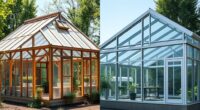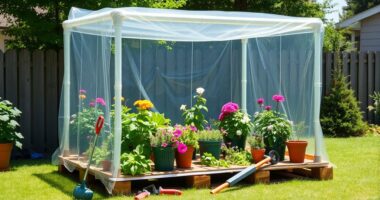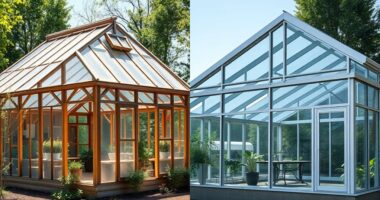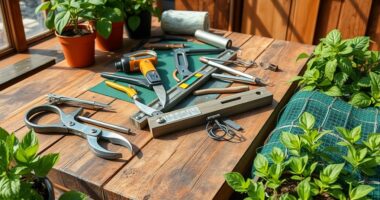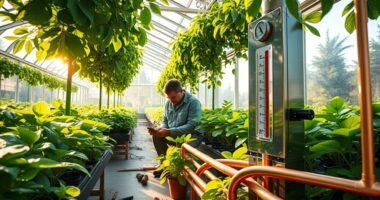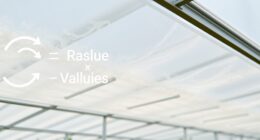Choosing the right materials for your greenhouse impacts durability, energy efficiency, and plant growth. Opt for high-quality glazing like glass or polycarbonate to balance sunlight transmission and heat control. Select frame materials resistant to corrosion and weather, ensuring longevity with minimal maintenance. Sustainable options like recyclable or locally sourced materials reduce environmental impact. Exploring advanced coatings and future innovations can further enhance performance. Keep exploring to discover the best materials tailored to your climate and goals.
Key Takeaways
- Choose glazing with appropriate solar transmission to balance light and heat for optimal plant growth and energy efficiency.
- Select durable, corrosion-resistant frame materials like treated aluminum or galvanized steel for longevity and low maintenance.
- Prioritize eco-friendly, recyclable materials with certifications to minimize environmental impact and promote sustainability.
- Consider impact resistance, fire safety, and structural strength when selecting materials suitable for your climate and design needs.
- Stay informed on emerging innovations like smart glass and bio-based plastics to enhance greenhouse performance and sustainability.
Understanding Glazing Options for Greenhouses
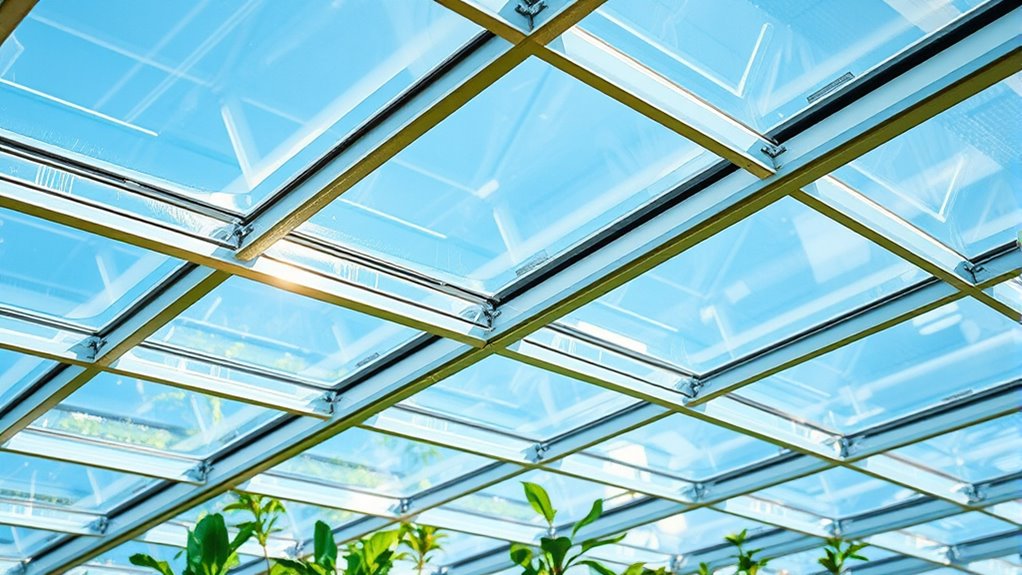
Have you ever wondered how the choice of glazing can impact your greenhouse’s performance? It all comes down to solar transmission and thermal insulation. Different glazing materials allow varying amounts of sunlight to pass through, affecting plant growth and energy needs.
High solar transmission maximizes sunlight, boosting photosynthesis, but can also increase heat gain, requiring better cooling systems. Conversely, low solar transmission reduces excessive heat, helping maintain a stable environment.
Thermal insulation is equally important; it minimizes heat loss during cold months, keeping your greenhouse warm and energy-efficient. Some glazing options, like double-pane glass or polycarbonate, offer better insulation, while others prioritize maximum sunlight. Vetted materials and advanced glazing technologies can further enhance these properties, providing more tailored solutions for specific climates. Recognizing the importance of glazing technology advancements allows you to select the most effective options for your needs.
Understanding these factors helps you select the right glazing to optimize plant health and energy use year-round. Additionally, considering remote work benefits such as flexible scheduling can help you dedicate time to properly evaluate and maintain your greenhouse environment, ensuring optimal conditions for your plants.
Moreover, being aware of climate considerations can guide you in choosing the most suitable glazing materials for your location.
Choosing the Right Frame Materials for Durability and Sustainability
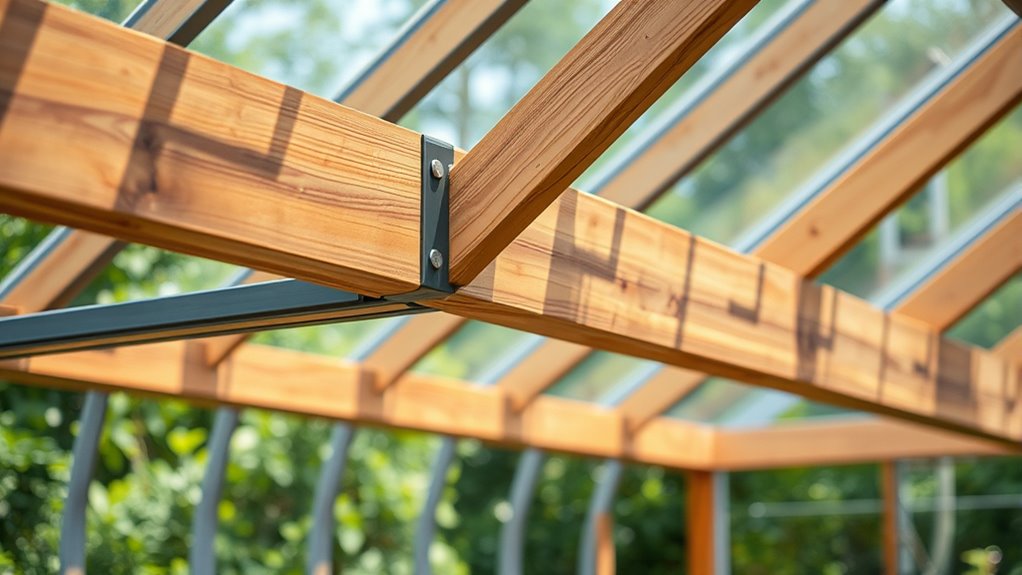
When selecting frame materials, you need to consider their longevity and strength to ensure your structure lasts. It’s also important to evaluate their environmental impact, from production to disposal, to make sustainable choices. Additionally, choose materials that are easy to maintain and repair, saving you time and resources over the long term. For instance, some materials may be better suited for supporting the structural integrity required for effective juice cleansing and detox routines, ensuring your greenhouse remains durable and reliable. Considering the filtration systems used in various materials can also influence their suitability and overall environmental footprint. Moreover, selecting materials with proven performance and reliability can contribute to the overall durability of your greenhouse structure. Incorporating materials with high thermal insulation properties can further enhance energy efficiency and climate control within your greenhouse. Understanding the relationship between material choice and greenhouse performance can help optimize your setup for longevity and sustainability.
Material Longevity and Strength
Choosing the right frame material is essential if you want your greenhouse to last and perform reliably over time. Material longevity depends on its resistance to material corrosion, which can weaken structural integrity. Materials like treated aluminum or galvanized steel resist rust and decay, extending the lifespan of your structure. Additionally, understanding cheating behaviors and their impact can inform maintenance and community trust in shared spaces like greenhouses. Recognizing corrosion resistance in materials can help prevent deterioration and costly repairs. Incorporating protective coatings can further enhance a material’s durability against environmental factors. Wood, if properly sealed, can also be durable, but it’s more prone to rot and pests. Considering the cost-effectiveness of each material can help you balance budget constraints with durability needs. Consider the strength of the material as well; it must withstand weather elements and environmental stresses without bending or cracking. A strong, corrosion-resistant material ensures your greenhouse maintains its structural integrity over years of use. Investing in high-quality, durable materials saves you money and effort in repairs, keeping your greenhouse stable and functional for the long term.
Environmental Impact Considerations
Considering the environmental impact of your greenhouse frame materials is essential for sustainable gardening. Choosing materials with strong recycling practices helps reduce waste and conserves resources. Look for options that can be recycled at the end of their lifespan to minimize landfill contributions. Incorporating active environmental practices into your material selection can further enhance the sustainability of your greenhouse. Eco label certifications also serve as a reliable indicator of environmentally responsible choices, ensuring the materials meet strict standards for sustainability and low environmental impact. Supporting sustainable manufacturing processes can help promote ecological balance and reduce pollution. Opting for certified products can support eco-friendly manufacturing processes and promote long-term ecological health. Additionally, considering material lifecycle assessments can give you a comprehensive understanding of the environmental impacts throughout a product’s lifespan. Evaluating the carbon footprint of different materials provides further insight into their overall environmental effects. Furthermore, consider the sourcing of your materials; locally sourced options often have a lower carbon footprint. Incorporating recyclable materials into your design can significantly reduce environmental impact and facilitate end-of-life disposal. Ultimately, selecting environmentally conscious frame materials helps you build a durable greenhouse while reducing your ecological footprint and fostering sustainable gardening practices.
Maintenance and Repair Ease
Selecting the right frame materials plays a crucial role in making your greenhouse easy to maintain and repair over time. Durable materials reduce the frequency of repairs and make panel cleaning simpler, saving you time and effort.
For example, aluminum frames resist frame corrosion better than steel, which can rust and weaken. This means less maintenance and fewer replacements. Choosing materials that are resistant to corrosion also ensures your greenhouse stays secure and stable. Additionally, selecting materials with corrosion resistance can help maintain the structural integrity over many years, reducing the need for costly repairs.
Additionally, low-maintenance frames simplify panel cleaning, preventing buildup that could affect light transmission. When selecting your frame material, consider how easily you can access and repair parts without disrupting your setup. Selecting materials with fire safety considerations can further enhance the safety and longevity of your greenhouse.
Prioritizing durability and ease of repair ensures your greenhouse remains functional and sustainable for years to come.
Insulation Techniques to Maximize Energy Efficiency

To maximize energy efficiency through insulation, you need to focus on proper installation and the right materials. Using effective thermal barriers prevents heat loss, keeping your greenhouse warmer in winter and cooler in summer.
Insulation panels are a popular choice, offering easy installation and high R-values. To optimize performance, consider these techniques:
- Ensure seamless installation without gaps or compression
- Use high-quality insulation panels with durable cores
- Install vapor barriers to prevent moisture buildup
- Seal all joints and edges to eliminate drafts
These steps help maintain consistent temperatures and reduce energy costs. Properly installed insulation not only conserves heat but also extends the lifespan of your greenhouse materials, making your structure more sustainable and cost-effective.
The Role of UV-Transmitting Materials in Plant Growth
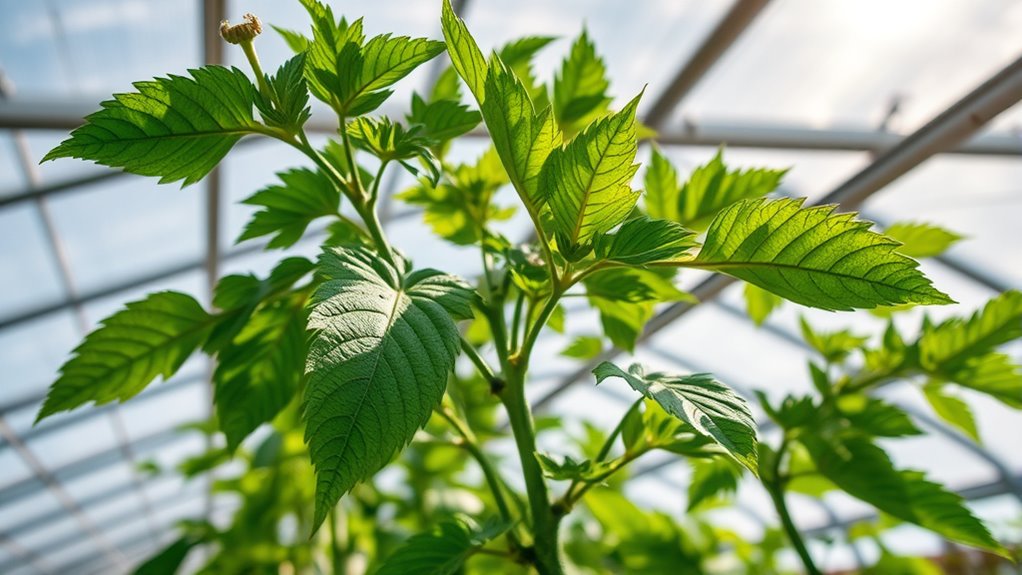
Have you ever wondered how specific materials influence plant growth in greenhouses? UV transmission plays a vital role. Materials that allow beneficial UV rays to pass through can boost plant health and development by stimulating natural growth processes and strengthening immune responses.
Proper UV-transmitting materials guarantee your plants receive the right amount of UV light without exposing them to harmful levels, promoting more vigorous growth. While some materials block UV rays to protect plants from damage, others are designed to transmit UV effectively, enhancing photosynthesis.
Choosing the right UV-transmitting material can lead to faster growth, better yields, and healthier plants. Remember, optimizing UV transmission is a key factor in creating a thriving greenhouse environment tailored to your plants’ needs.
Comparing Glass, Polycarbonate, and Other Glazing Types

When choosing glazing materials for your greenhouse, understanding the differences between glass, polycarbonate, and other options is essential. Each material offers unique benefits, especially regarding solar transparency and aesthetic appeal.
Glass provides high solar transparency, maximizing light for plant growth and offering a classic look. Polycarbonate is durable, impact-resistant, and provides good light diffusion, though it can slightly reduce solar transparency. Other options, like acrylic or specialized films, vary in light transmission and appearance.
Consider these points:
- Glass: High solar transparency, excellent aesthetic appeal, but more fragile.
- Polycarbonate: Durable, impact-resistant, moderate solar transparency.
- Acrylic: Lighter than glass, decent transparency, less scratch-resistant.
- Films: Cost-effective, customizable, variable transparency and aesthetics.
Choose based on your climate, design preferences, and plant needs.
Environmental Impact of Greenhouse Materials
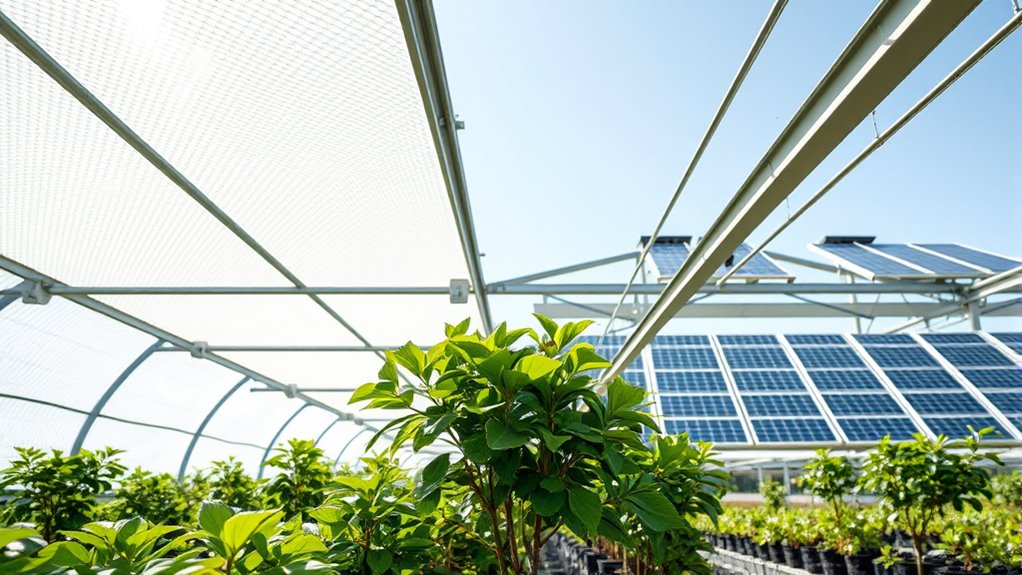
Choosing eco-friendly materials can notably lower your greenhouse’s environmental impact.
By focusing on options that reduce the carbon footprint, you help promote sustainability.
Every material decision you make plays a vital role in protecting the planet for future generations.
Eco-Friendly Material Choices
Ever wondered how the materials used in greenhouse construction impact the environment? Choosing eco-friendly options helps reduce your carbon footprint and supports sustainability.
Recyclable materials, like certain plastics and metals, can be reused or repurposed, minimizing waste. Biodegradable options, such as plant-based plastics or natural fibers, break down safely without harming ecosystems.
When selecting materials, consider these points:
- Opt for recyclable plastics and metals to lessen landfill waste
- Use biodegradable materials to reduce long-term pollution
- Avoid toxic coatings or treatments that release harmful chemicals
- Prioritize locally sourced materials to cut transportation emissions
Making thoughtful choices ensures your greenhouse is both productive and environmentally responsible, helping you contribute to a greener future.
Carbon Footprint Reduction
The materials you select for your greenhouse play a significant role in determining its overall carbon footprint. Opting for recycled or recyclable materials helps reduce waste and energy consumption during production. Look for products involved in recycling initiatives, which guarantee materials are reused rather than discarded.
Additionally, choosing materials with eco label certifications ensures they meet strict environmental standards, further lowering your greenhouse’s impact. By prioritizing sustainable options, you minimize the carbon emissions associated with manufacturing and transportation.
These choices encourage a circular economy and support eco-friendly practices. Ultimately, your focus on recycled materials and certified eco-friendly products not only benefits the environment but also enhances your greenhouse’s sustainability and long-term viability.
Cost Considerations and Long-Term Savings

While some materials may cost more upfront, investing in higher-quality options can lead to significant long-term savings through better cost analysis and improved investment returns.
Choosing durable materials reduces the need for frequent repairs and replacements, saving you money over time.
To maximize savings, consider:
- Energy-efficient glazing options that lower heating costs
- Strong, weather-resistant framing materials with longer lifespans
- Insulation that enhances climate control and reduces energy use
- Recyclable materials that lower disposal expenses and support sustainability
Maintenance and Durability of Different Materials
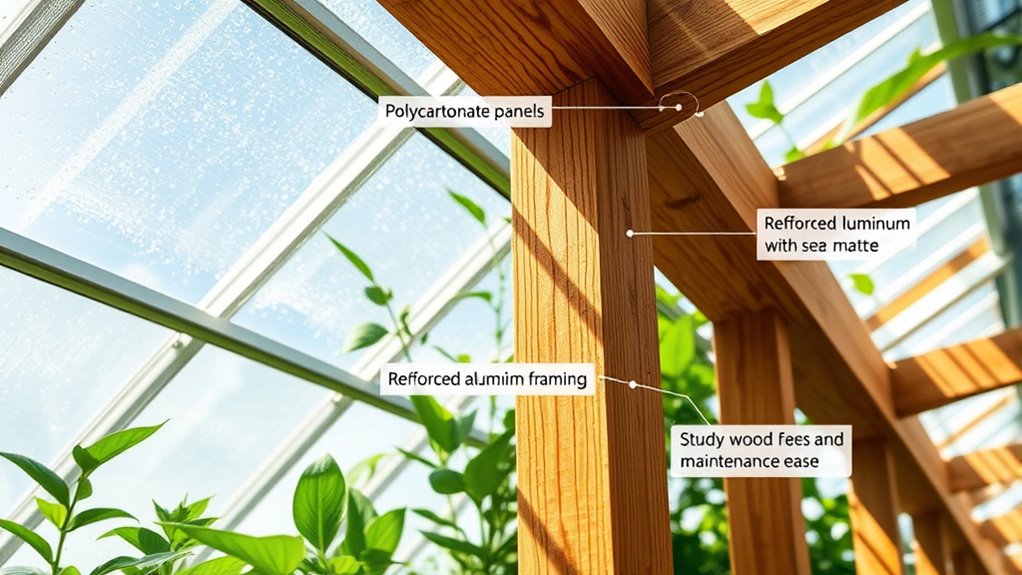
Choosing durable materials not only affects your initial investment but also impacts ongoing maintenance requirements. Materials with high weather resistance, like galvanized steel or treated wood, withstand harsh conditions better and reduce the need for frequent repairs.
Be mindful of material corrosion, which can weaken structures and increase upkeep costs. For example, untreated metal may corrode quickly without proper coating, leading to structural issues.
Polycarbonate panels offer excellent weather resistance and resist cracking, making them a low-maintenance choice. Conversely, glass might require regular cleaning and inspection to prevent damage.
Innovations in Greenhouse Materials and Future Trends
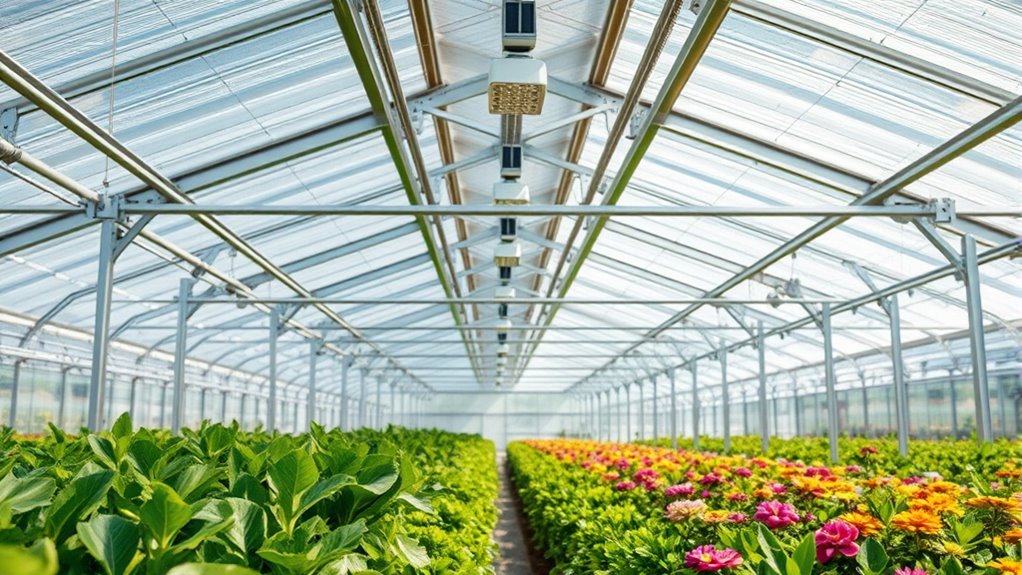
Advancements in greenhouse technology are driving the development of innovative materials that promise to enhance efficiency and sustainability. Smart glass, which adjusts transparency based on sunlight, helps regulate temperature and light, reducing energy costs.
Innovative greenhouse materials like smart glass boost efficiency and sustainability through adaptive light and temperature regulation.
Bio-based plastics are gaining popularity as eco-friendly alternatives to traditional materials, offering durability and biodegradability. Future trends include the integration of these materials to create more energy-efficient, sustainable structures.
You can expect:
- Enhanced insulation and light control with smart glass
- Increased use of bio-based plastics for framing and panels
- Development of self-healing and adaptive materials
- Incorporation of nanotechnology for improved durability and performance
These innovations are shaping a greener, smarter future for greenhouse design, making it easier for you to grow sustainably.
Frequently Asked Questions
How Do I Choose Materials Suitable for Extreme Weather Conditions?
When choosing materials for extreme weather, focus on wind resistance and thermal insulation.
Opt for sturdy, wind-resistant panels like polycarbonate or reinforced glass to prevent damage.
Look for materials with high thermal insulation properties to maintain stable temperatures inside your greenhouse.
You should also consider durability and ease of installation.
Are There Eco-Friendly Options for Greenhouse Framing Beyond Traditional Materials?
You can explore eco-friendly options for greenhouse framing by considering alternative framing made from recycled materials like reclaimed wood, recycled plastic, or metal.
Recycling options are plentiful, helping reduce waste and environmental impact. These sustainable choices provide durability and strength while supporting eco-conscious gardening.
What Are the Best Materials for Controlling Humidity Inside a Greenhouse?
Did you know that proper humidity control can boost plant growth by up to 20%? When selecting materials for your greenhouse, focus on options that help regulate humidity efficiently.
Polycarbonate panels and vapor barriers are excellent choices because they minimize moisture loss and prevent excess humidity. Good material selection guarantees stable climate conditions, reduces mold risks, and promotes healthier plants.
Making these choices can make your greenhouse more productive and sustainable.
How Do Material Choices Affect Pest and Disease Management?
Your material choices directly influence pest resistance and disease prevention in your greenhouse. Using durable, pest-resistant materials like galvanized steel or insect-proof screens can keep pests out.
Additionally, choosing non-porous, easy-to-clean surfaces reduces disease buildup, preventing fungal and bacterial infections. Properly selecting and maintaining these materials helps you create a healthier environment, minimizing pest and disease issues, and ensuring your plants stay vigorous and productive.
Can I Retrofit Existing Greenhouses With Newer, More Sustainable Materials?
Yes, you can retrofit your existing greenhouse with newer, sustainable materials. Focus on upgrading greenhouse insulation to improve energy efficiency and choose materials with high durability to withstand weather conditions.
Conclusion
Choosing the right materials for your greenhouse is like planting seeds for a thriving future. With thoughtful selections, you craft a sanctuary where your plants can reach for the sun, protected and nurtured. Every panel, frame, and layer becomes a brick in your garden’s foundation—building a resilient, vibrant haven. Remember, your choices today shape a lush, sustainable tomorrow, where growth blossoms under the steady watch of materials that stand the test of time.

